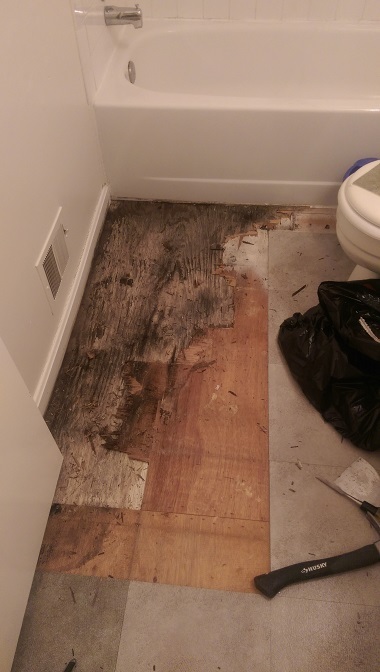Have you been on the lookout for facts concerning How to Fix a Water Damage Bathroom?

The washroom is extremely at risk for wet buildup and also possible water damages as a result of the constant use water in it. This post uses basic examination strategies to aid finding water damage risks.
The regular use of water in the washroom makes it exceptionally prone for damp build-up and potential water damage. By evaluating it on a regular basis, you can decrease water associated damages.
The following collection of examinations is simple to do as well as should be done as soon as in every 3 months in order to keep your bathroom healthy and to stop prospective water damages brought on by the tub, the shower, pipe joints and also plumbing, sinks, cabinets, and also the bathroom
Do not neglect executing these assessments and also be complete while performing them. Remember that these easy examinations can save you a great deal of money by providing very early indications for water damages
Bathtub as well as Shower
The shower and bath tub require unique attention and also maintenance. Examine the tiles as well as replace if split. Make sure that there is no missing out on cement between the ceramic tiles. Evaluate as well as replace split caulking at joints where the walls fulfill the floor or the bath tub. Blocked drains as well as pipes issues will protect against the bathtub from drying out as well as might suggest significant issues under the tub. Consult with an expert quickly to avoid architectural damage. Take notice of discolorations or soft locations around the bathtub wall surfaces as they may suggest an internal leakage.
Plumbing
Signs for water damage are hard to discover since the majority of pipes are installed inside the walls.
Pay unique focus to floor covering and also walls dampness as well as stains as they might suggest an undetectable plumbing issue. Inspect dampness degrees in adjoining rooms also.
Sinks and also Cabinets
Sinks and closets are exposed to dampness and also humidity daily and also are frequently ignored. Evaluate frequently under the sink and also on the countertop above it. Fix any drip in the catch as it might suggest drain problems. Take a look around the sink, sluggish draining pipes may indicate an obstructed drain. Change sink seals if they are fractured or loose.
The Bathroom
The toilet is an at risk water joint. Examine the water lines as well as search for leaks around the bathroom seat, in the hose pipe, and also under the water container. If you find any signs of wetness on the floor around the toilet, check for leakages in the toilet edge as well as container seals.
Know that hanging bathroom bowl antiperspirants enhances the opportunities for blockages.
Water Damage Signs In The Bathroom To Avoid Cleanup
Musty smell
This is one of the easiest signs to catch because musty smells are so odorous. The damp, earthy, moldy smell should be a big red flag. The smell will develop when moisture gets trapped in surfaces, and begins to facilitate mold growth. Leaking pipes under cabinets, inside walls, and behind shower fixtures will cause moisture to stay trapped and not dry, which will lead to mold growth and spread. As soon as you notice any musty smells in your bathroom, have it checked for hidden water damage and cleanup signs.
Visible mold
If the smell isn’t there to give it away, sometimes you will actually see mold growth. Finding mold in your bathroom is a serious problem, because mold is very harmful to your health. By the time mold growth is visible, it also means that water damage has already occurred and been present for some time. The only way the mold problem can be resolved is to find the source of the moisture and get it stopped. To safely and adequately remove mold, you need to have professionals handle the remediation. Do not waste any time in getting mold problems addressed, fixed, and sanitized so that you can protect you and your family from the many respiratory symptoms caused by mold exposure.
Damaged floors
Bathroom floors should be able to withstand some exposure to water while still remaining in good condition. However, when excess exposure or water leaks occur, they will begin to damage even the most water-resistant flooring. If you notice any cracking, bubbling, staining, or warping on your bathroom floors, there is probably a water leak somewhere causing the distortion. If you notice areas of the floor have become softer, or even have a spongy feeling, there is probably damage to the subfloor. Subflooring is typically made up of plywood. When plywood is exposed to water or moisture, it will absorb it. Once it has become saturated, the weight of the excess water will cause the wood to swell and soften. Check the floors in your bathroom frequently to catch any of these sings before they lead to damaged subflooring.
Changes on walls
When water leaks behind walls, it will cause changes in the drywall. Peeling plaster, blistering paint, and soggy wallpaper are all good indicators that excess water is building up behind the wall. Water leaking behind drywall will cause it to swell and be soft to the tough. If you start to notice gaps along the trim of your walls, or where tile meets the wall, it could also be a strong indicator that there is a leak behind the wall. Any changes, distortion, or damage on the walls should be evaluated as soon as you notice it to prevent further water damage and cleanup.

We had been shown that editorial on How to Fix a Water Damage Bathroom through an acquaintance on our other web property. Kindly set aside a second to share this blog if you liked it. Thanks so much for your time spent reading it.
See Availability